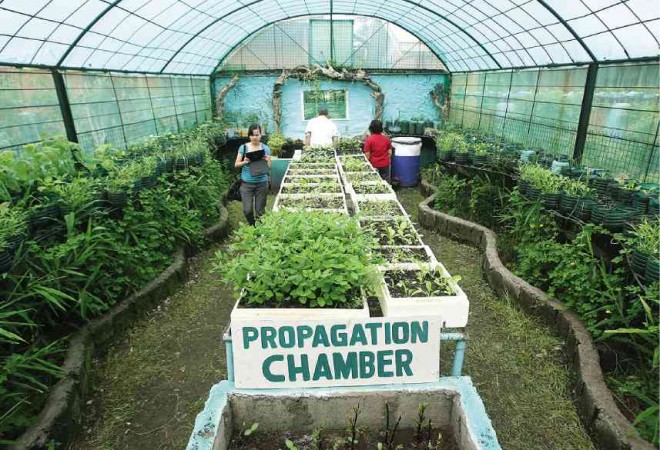‘Bahay Kubo’ veggies thrive in school gardens

A FUNCTIONING nursery is among the features of a sustainable Gulayan sa Paaralan. PHOTOS BY MARIANNE BERMUDEZ
Every elementary pupil may know “Bahay Kubo” by heart, but only a few may be able to identify the vegetables mentioned in the folk song.
“This is because we are losing our agrobiodiversity,” said Julian Gonsalves of International Institute of Rural Reconstruction (IIRR) on a visit to a school garden at San Roque Elementary School (SRES) in Naic town, Cavite province.
“We have patani, we have bataw in the ‘Bahay Kubo’ (song), but now you can’t find bataw and patani in the market,” he said.
To reintroduce new generations to the “Bahay Kubo” vegetables, IIRR plans to showcase over a hundred indigenous plants in “crop museums” across 27 Cavite public elementary schools.
What Filipinos were forgetting, said IIRR project coordinator Maria Christy Jesusa Tacugue, was that local plants were better suited here. “They are hardy, tough, disease-resistant and sustainable,” she said.
Article continues after this advertisementGonsalves said: “The Food and Nutrition Research Institute came up with a list of the Top 25 vegetables many years ago. Except for carrot, all were indigenous, [with] higher nutritional [and] fiber contribution.”
Article continues after this advertisementThe IIRR decided it would help ensure that at least seven out of 10 plants in school gardens participating in Gulayan sa Paaralan would, “at any given time,” be indigenous.
Planting and feeding
The Gulayan sa Paaralan program combines agriculture lessons with the Department of Education’s supplemental feeding program for malnourished kids. It aims to help reduce the high malnutrition incidence in the 6-10 age group.
“In the past, we might not have taken a holistic view, so we tried to look at the combination,” Gonsalves said of the project supported by Canada’s International Development Research Center.
At the SRES nutrition fair, guests sampled recipes offered in a three-week supplementary feeding menu developed by teachers.
The 27 participating schools drew from produce in their gardens to make embutido and 14 other recipes, both attractive to and nutritious for kids.
The fair also displayed modules integrating school gardens into science and other subjects. A module from Indang Central School encouraged students to compose songs about nutrition.
Now in its last year, the three-year action research is aiming for self-sufficiency.
“I’ve been working with gardens for 25 years in the Philippines and sustainability has been the big issue. One time, it’s there and then another time, it’s not,” Gonsalves said. The cost of seeds and fertilizers was often the problem.
To help ensure the sustainability of Gulayan, IIRR introduced bio-intensive gardening.
Only a small parcel of land is planted and the school produces its own fertilizer.
Going organic
Gonsalves said organic farming was cheap and safer, as residue from chemical fertilizer could cause health problems.
Gonsalves said IIRR developed a simplified composting process for “reengineered” gardens and trained teachers from Calabarzon (Cavite, Laguna, Batangas, Rizal and Quezon provinces).
The perimeter of the school garden is planted to kakawate or madre de cacao to produce material for compost. The trees also help maintain the microclimate needed by the garden.
Planting beds are higher to keep plants safe from floods and dug deeper to store more water and help roots grow deep. When schools close for the long vacation, cover crops, usually cowpea or payap and rice bean or tapilan, are planted. This conserves soil moisture and prevents weeds from taking over the garden.
Education Secretary Armin Luistro said he was glad to see that the gardens were truly fruitful and sustainable.
Although he praised the campaign materials, functional nursery and recipes, he said it would take more to make the program truly successful.
“Is gardening for agriculture teachers only?” he asked, as he encouraged schools to look at crop museums as “living museums” for science and arts, where children could learn about “weather and the effect of too much or too little water… and organization.”
He said lessons and best practices from one school should be suitable for replication in other areas. Reciting lines from “Bahay Kubo,” the secretary enjoined everyone to raise the country from its current status of having the lowest vegetable consumption in Asia.
Menus could be copyrighted for cookbooks and lesson plans used as models nationwide, Luistro said.
The “Bahay Kubo” culture surrounding the project, the secretary said, must radiate out of schools.
“If someone wants eggplants, don’t give him eggplants,” he said. “Instead, give him seeds and teach him to care for them.”


